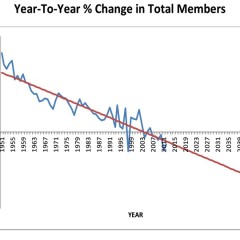
In 1971, 15,000 messengers gather for the 114th annual meeting of the Southern Baptist Convention in St. Louis, MO.
There will be a lot of talking in Houston, Texas this week. After all, the Bayou City is hosting the 2013 annual meeting of the Southern Baptist Convention (SBC). Messengers from America’s largest Protestant denomination are expected to discuss several topics, from the Boy Scouts’ new policy admitting gay youths to a range of theological doctrines. But one unwelcome point of discussion this year has been the denomination’s decline.
According to data released this week by LifeWay Research, the arm of the denomination that tracks such trends, the number of SBC-affiliated congregations grew while reported membership of those churches declined by more than 100,000. This number is down 0.7 percent from last year with primary worship attendance declining 3.1 percent to 5.97 million Sunday worshippers. Baptisms decreased by 5.5 percent over the previous year with the lowest reported number on record since 1948.
“The Christian Post” reports that this year’s is the fifth dip in a row for the denomination, the “Associated Press” says the drop represents a six-year trend, and LifeWay Research claims it spans 50 years. Regardless, the denomination is failing to keep up with population growth. According to LifeWay Research, if the SBC’s membership trends continue it will hit 1960 levels by 2050.
“Statistically, our light is dimming,” said LifeWay’s Ed Stetzer at the SBC’s Pastors Conference on Monday. “We’re losing our saltiness.”
Stetzer is addressing both the declining numbers and waning cultural influence of the SBC, a problem compounded by the way its congregations, pastors and members seem to be distancing from the denomination they affiliate with. In 1999, the “Associated Press” reported on a trend among SBC churches who were dropping “Baptist” from their name. To curb this trend, the denomination approved an alternate label—”Great Commission Baptists”—that could be used by member congregations. I’ve yet to locate a single church that has actively utilized the moniker.
Another trend illustrating decreased denominational loyalty among member churches is the plummeting attendance of the SBC’s annual meeting. LifeWay reports a precipitous drop over the last decade. As of Tuesday morning, fewer than 5,000 messengers were registered for the event, down from an annual average of 7,670 between 2000 and 2012.
No matter how you look at the data, it seems to indicate trouble is on the horizon for the SBC.
As a lifelong Southern Baptist who grew up singing the Baptist Hymnal and whose father served as president of the denomination from 2000 to 2002, these trends are disheartening. But they are also understandable.
In recent years, I’ve watched my denomination fight vicious battles over issues of little importance. I’ve seen them dive headfirst into divisive partisan politics. And I’ve witnessed how anyone who doesn’t bow down to the institutional machine or even dares to question the status quo is not-so-kindly shown the door. No wonder the denomination is shrinking.
A new day is dawning in American religious life in which Christians of many stripes seem to be running fast and hard from denominations, particularly those whose behavior mirrors the descriptions listed above. If the Southern Baptist Convention wants to survive in this era, I believe they must learn to do at least three things:
1. Put first things first. “You can’t get second things by putting them first,” C.S. Lewis once wrote. “You get second things only by putting first things first.” Lewis knew what the Southern Baptist Convention has often forgotten: priorities often determine effectiveness.
If you review the resolutions, reports, and microphone grandstands of the SBC’s annual meeting during recent years, you’ll find a lot of energy expended on secondary things. The “Associated Press” reported this week on how debates over Calvinism is dividing the Convention. Add to this recent squabbles over the so-called “sinner’s prayer” and other lesser issues, and you have a denomination that expends major energy on minor issues.
The SBC’s resolution history also seems to bear this out. There was the ineffective 1997 boycott on Disney, a resolution to retain the traditional method of calendar dating (B.C. / A.D.) in 2000, and a 2011 resolution disapproving of the revision to the world’s most popular Bible translation (NIV), which requested that LifeWay Christian Stores stop carrying it. (One year later, LifeWay still sells the translation.)
If the Southern Baptist Convention wants to regain the credibility, interest, and relevance it has lost, the denomination must learn to put first things first. Namely, sharing the gospel through missions and showing the gospel through acts of service, compassion, and justice.
2. Eschew partisan politics. Tony Campolo once said that mixing the church with government is “like mixing ice cream with horse manure: You will not ruin the horse manure, but it will ruin the ice cream.” I’ll let you determine which one is the ice cream in his analogy.
During the last 25 years, the Southern Baptist Convention has rushed headlong into conservative politics, often parroting Republican talking points and baptizing the GOP’s agenda. Just last year, Richard Land, former head of the SBC’s political arm, broke tradition and publicly endorsed Mitt Romney for President.
Of the 117 resolutions passed by the denomination at their annual meeting since 2000, a breathtaking 70 of them have been political. This includes a 2003 resolution endorsing President Bush’s war in Iraq, a 2008 resolution taking a position in the so-called “War on Christmas,” and a 2009 resolution titled “On President Barack Hussein Obama.” I keep waiting for a resolution naming Sean Hannity as an honorary fourth member of the Trinity.
American evangelicalism is becoming more politically diverse and nuanced than it once was, particularly among young people. If the denomination continues to operate like a Republican lapdog, it can expect to be seen as a polarizing political institution. If they can learn to speak truth to power on both sides of the aisle, the SBC stands a chance of restoring its image. Americans want a Church that is prophetic, not partisan.
3. Learn to listen. The late Henri Nouwen once remarked, “without listening, speaking no longer heals.” He’s right. When all we do is talk, our words become a monotone melody heard only by ourselves. Therefore, any organization or leader must maintain an ongoing commitment to listen to others.
One demographic that Southern Baptists need to listen to more often is the next generation. LifeWay reported in 2008 that the percentage of messengers in the 18-39 age group attending the annual meeting has declined steadily since 1980 while the percentage of messengers in the 60-and-older group has increased dramatically.
I’ve seen many young leaders over the years that were all but required to run a leadership gauntlet—genuflecting to the Southern Baptist aristocracy along the way—before being offered a seat at the table. Again and again, the Southern Baptist Convention has gone the way of the wolf spider, cannibalizing their young. Meanwhile, other Christian communities and gatherings—Catalyst, Exponential, Thrive, Justice Conference—welcome young people and their fresh ideas. The next generation flocks to these organization’s events by the thousands while saturating the SBC with their absence.
If the Southern Baptist Convention has any hope for regaining their place of prominence, it must raise up a capable and passionate crop of young and diverse leaders. This means learning to listen to the sometimes uncomfortable and seemingly iconoclastic ideas of next generation thinkers.
“If we are just a bunch of bitter old church people, grumpy at the world, yelling at non-believers to get off our proverbial moral lawn,” Ed Stetzer told SBC leaders on Monday, “that does not show forth light and preserve as salt.”
The denomination must now decide whether to chart a new path for the sake of its future or maintain its current course. But one thing is certain. When the convention gathers for its annual meeting in another decade, people will still be talking. The question is now, “Will anyone be listening?”






